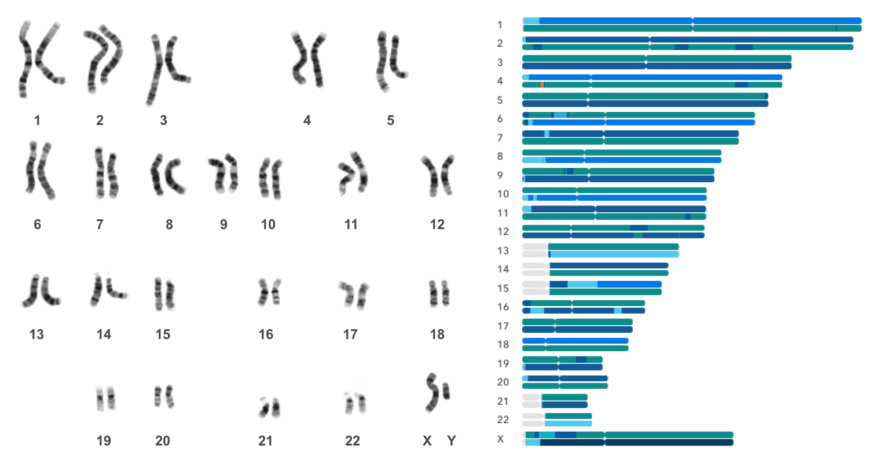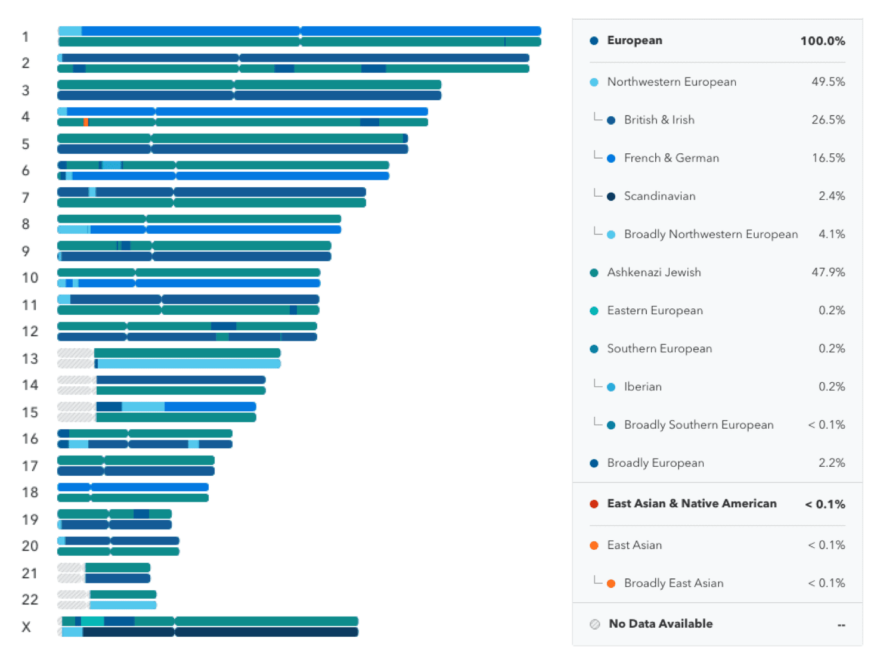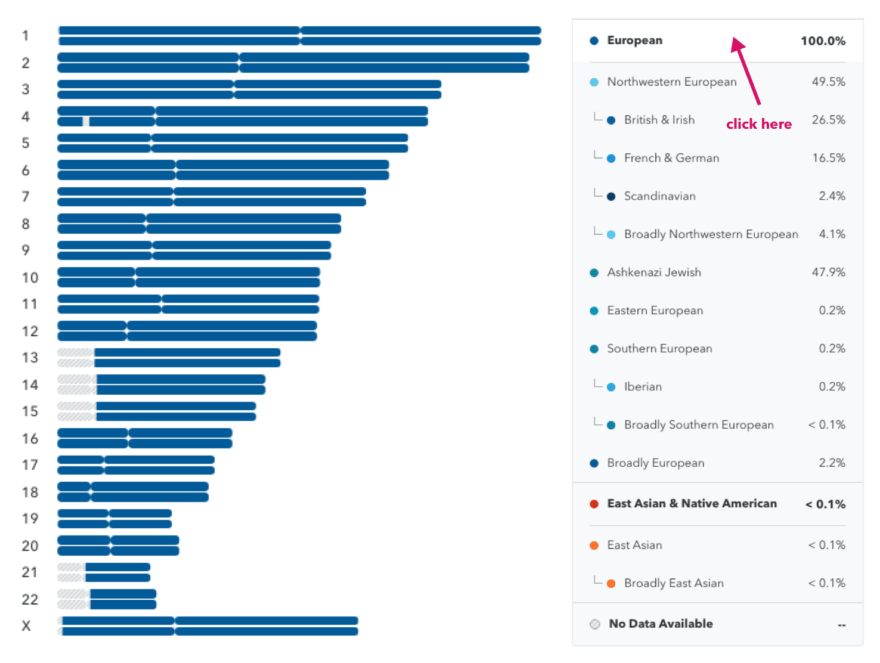Sarah Laskey, 23andMe Product Scientist
The Chromosome Painting is one of my favorite parts of the 23andMe experience because it is packed with information. Then again, it can also be a little intimidating because it shows so much all at once. In this blog post, I’ll walk through some basics of what your Chromosome Painting shows. And I’ll explain what kinds of stories it can tell you about your genetic ancestry.
What is a Chromosome Painting?
Your Chromosome Painting is another way of looking at your Ancestry Composition results. It shows a colorful representation of the 23 pairs of chromosomes that make up your genome. Here is a photo of what real human chromosomes look like under a microscope, side by side with my Chromosome Painting:
In the microscope photograph on the left, the chromosomes are laid out vertically. In the Chromosome Painting on the right, they’re shown as colorful horizontal bars. In both images, the chromosomes are shown in pairs and labeled with numbers (1 through 22) or the letters X and Y.
My Chromosome Painting has two copies of the X chromosome because I’m female. The picture on the left shows the genome of a biological male, who has one copy of the X chromosome and one copy of the Y chromosome. Y chromosomes aren’t shown in Chromosome Paintings.
In the Chromosome Painting, gray regions in chromosomes 13, 14, 15, 21, and 22 represent parts of the genome where 23andMe doesn’t test any markers because the DNA sequences in those regions are repetitive and hard to measure.
Exploring your genetic ancestry
In your Chromosome Painting, your genome is “painted” with colors representing up to 31 different ancestries. You can hover over or click on the different ancestries in your Chromosome Painting to learn where they’re found in your genome.
The 31 Ancestry Composition populations are organized in a hierarchy, which reflects the genetic structure of global populations. For example, Britain and Ireland are part of Northwest Europe, which is part of Europe. To see this hierarchy in action, take a closer look at my Chromosome Painting:

My Chromosome Painting shows genetic ancestry from several different fine-resolution populations like British & Irish, French & German, and Ashkenazi Jewish. But these are all sub-categories of European. When I click “European” on the right hand sidebar, my whole genome is colored in “European blue”:

What can you do with your own high-resolution picture of the Ancestry Composition on each of your chromosomes? You can click on the different populations to understand how they relate to each other and where they’re found in your genome. You also can talk to family members (or connect with them on 23andMe) to learn which branches of your family contributed which parts of your genetic ancestry.
One segment, two segment, red segment, blue segment
The colors in your Chromosome Painting tell you about your Ancestry Composition, but you can learn even more by looking at the number and length of the DNA segments assigned to each ancestry. Everyone inherits half of their DNA from their mother and half from their father. When DNA is passed from parents to their children, the two chromosomes in each pair are randomly shuffled together in a process called recombination.
This process breaks up long segments of a single ancestry into shorter segments. Sometimes very short segments of ancestry are lost during recombination and don’t get passed to the next generation. This is why ancestry from your distant ancestors only shows up in a few short segments of your genome, if at all.
The technical term for the genetic mixing of previously separate populations is admixture. If you have different DNA segments painted with different colors in your Chromosome Painting, those are evidence of admixture in your genetic history. Take a look at these two Chromosome Paintings side by side:

Every Chromosome Painting Tells a Story
These Chromosome Paintings show very different genetic histories, and not just because of their Ancestry Compositions! Even if we ignore the colors themselves, the two pictures are pretty different. The long, unbroken stretches of color on the left are evidence of recent admixture, while the short segments of different ancestries on the right suggest admixture many generations ago.
My Chromosome Painting is the one on the left. I have one grandparent whose family came from Germany, one grandparent whose family came from Ireland, and two Ashkenazi Jewish grandparents. In other words, my ancestors from different European populations just started mixing together in the past two or three generations. The Chromosome painting on the right shows someone who identifies as Latino (Antonio, an Engineer at 23andMe), whose Native American (yellow), African (pink) and European (blue) ancestors probably started mixing with each other many generations ago.
How can you use this information to understand your own Chromosome Painting? In general, if your most recent ancestor from a population was very recent, you will have segments of that ancestry on more chromosomes, and those segments will be longer, than if your most recent ancestor was many generations ago.
Thanks, Mom and Dad!
If you have a biological parent or child who is also a 23andMe user, you can connect with them to improve the resolution of your Ancestry Composition results.
Connecting with a parent will also reorganize your Chromosome Painting so that the top chromosome in each pair is the one you inherited from your mother, and the bottom chromosome is the one you inherited from your father.
Connecting or not with a Parent
Even if you are not connected with either of your parents through 23andMe, you may still be able to learn a little bit about their ancestry by looking at your own Chromosome Painting:
- If you are male, you inherited all of the ancestry painted on your X chromosome from your mother.
- If you have the same ancestry painted in the same place on both copies of a chromosome, then you inherited the same ancestry from both of your parents in that region of your genome.
- If you share a segment of DNA with a DNA Relative, and you know whether you are connected to that relative on your maternal or your paternal side, then you inherited that segment of DNA (and its ancestry) from the same side of your family through which you’re connected to that relative.
- If your parents come from different genetic backgrounds, then you may be able to guess which chromosomes you inherited from which of your parents. You can do this by by looking at the ancestries painted on each chromosome. For technical reasons, this will work even better if you are connected with a parent. That is because our computational algorithm will be able to phase your raw data with more accuracy.
A deeper dive: Confidence levels
If you’ve mastered the basic details of your Chromosome Painting and you’d like to explore at an even more advanced level, click on “Change confidence level” and move the slider that appears above your Chromosome Painting. You can explore the different views of your Chromosome Painting at different confidence levels. You can also compare those different views to each other.

The algorithm we use to calculate your Ancestry Composition analyzes one small piece of your DNA at a time. For each piece of your DNA, we calculate the probability of that piece coming from 31 different populations. The confidence slider on the Chromosome Painting allows you to explore our estimates of your genetic ancestry at different probability cutoffs. For example, if a segment of your DNA has a 55 percent chance of being Japanese, then that segment will be painted as Japanese at the 50 percent confidence level. But at the 60 to 90 percent level it will be painted with a more broad ancestry (either Broadly East Asian, Broadly East Asian & Native American, or Unassigned).
Putting it all together
Everyone’s genetic history is a little different. Every Chromosome Painting has a different story to tell too. This means that you may learn more about your ancestry from some of the suggestions in this blog post than from others. Just remember – like every true work of art, your Chromosome Painting isn’t something to be understood. It’s something to be explored.
For a detailed technical explanation of how we calculate your ancestry and paint your chromosomes, check out the Ancestry Composition Guide.

